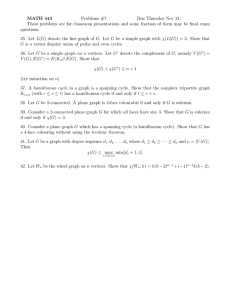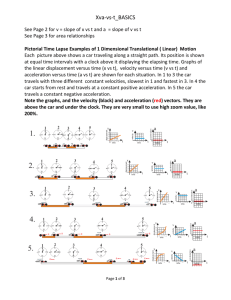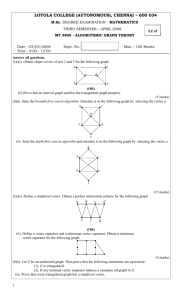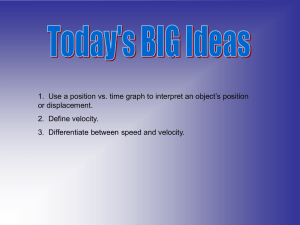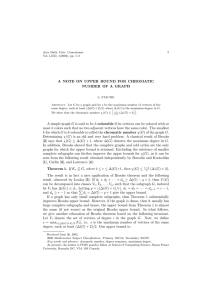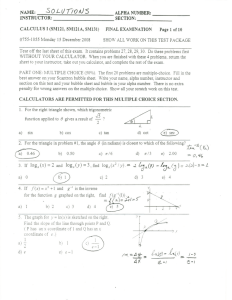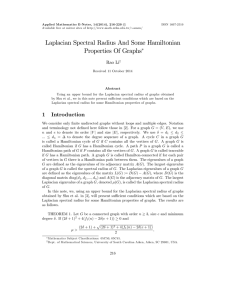Structural MRI connectivity analyses using graph the spectrum of AD
advertisement
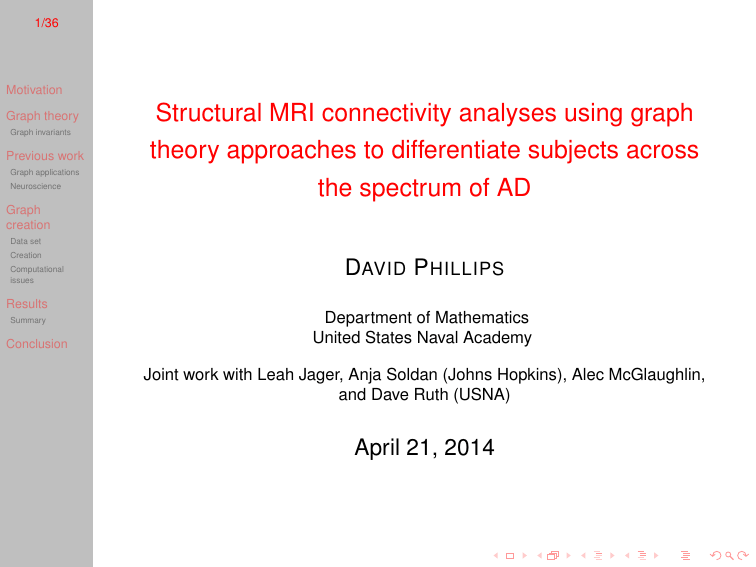
1/36 Motivation Graph theory Structural MRI connectivity analyses using graph Graph invariants Previous work theory approaches to differentiate subjects across Graph applications Neuroscience the spectrum of AD Graph creation Data set Creation Computational issues DAVID P HILLIPS Results Summary Conclusion Department of Mathematics United States Naval Academy Joint work with Leah Jager, Anja Soldan (Johns Hopkins), Alec McGlaughlin, and Dave Ruth (USNA) April 21, 2014 2/36 Motivation Graph theory Graph invariants Previous work Graph applications Neuroscience Graph creation Data set Creation Computational issues Results Summary Conclusion Analysis technique: • Obtain imaging data for a group of subjects. • Derive graphs for the subjects. • Measure some properties of the graphs to differentiate across the spectrum of AD. 3/36 Occam’s/Ockham’s razor? Motivation Graph theory Graph invariants Previous work Graph applications Neuroscience Graph creation For every complex problem there is an answer that is clear, simple, and wrong. –H.L. Mencken Data set Creation Computational issues Results Summary Conclusion Problems worthy of attack prove their worth by hitting back. –Piet Hein 3/36 Occam’s/Ockham’s razor? Motivation Graph theory Graph invariants Previous work Graph applications Neuroscience Graph creation For every complex problem there is an answer that is clear, simple, and wrong. –H.L. Mencken Data set Creation Computational issues Results Summary Conclusion Problems worthy of attack prove their worth by hitting back. –Piet Hein What graph creation methods and measures, if any, work best to differentiate across the AD spectrum? 4/36 Motivation Graph theory Graph invariants A graph G = (N, E) consists of a set N of nodes and a set E of edges which indicate relationships between pairs of nodes. Previous work Graph applications Neuroscience 5 6 Graph creation Data set 7 Creation Computational issues Results 3 Summary 4 Conclusion 1 2 5/36 Paths and connectivity Motivation Graph theory Graph invariants Previous work Graph applications Neuroscience Graph creation Data set • A path is a sequence of nodes with edges between consecutive nodes. • Nodes are connected if there is a path between them. • The path length is the number of edges in the path. 5 6 Creation Computational issues 7 Results Summary Conclusion 3 1 4 2 7 − 5 − 3 − 4 − 2 is a path of length four. All nodes here are connected. 6/36 Analyzing graphs Motivation Graph theory Graph invariants Previous work Graph applications Neuroscience Graph creation Data set Creation Computational issues Results Summary Conclusion • The complexity of graphs increases exponentially as nodes and edges increase. 6/36 Analyzing graphs Motivation Graph theory Graph invariants Previous work Graph applications Neuroscience Graph creation • The complexity of graphs increases exponentially as nodes and edges increase. Data set Creation Computational issues Results Summary Conclusion • Graph invariants are node label independent functions that can measure features such as efficiency and assortativity. 7/36 An efficiency graph invariant Motivation Graph theory Graph invariants Previous work Graph applications Neuroscience Graph creation Data set Creation Computational issues Results Summary Conclusion • The shortest path between two nodes is the path with shortest length. 7/36 An efficiency graph invariant Motivation Graph theory Graph invariants Previous work Graph applications • The shortest path between two nodes is the path with shortest length. Neuroscience Graph creation 5 6 Data set Creation 7 Computational issues Results 3 Summary 4 Conclusion 1 • 1 − 2 − 4 − 6 − 5 is a path of length 4. 2 7/36 An efficiency graph invariant Motivation Graph theory Graph invariants Previous work • The shortest path between two nodes is the path with shortest length. Graph applications Neuroscience 5 6 Graph creation Data set 7 Creation Computational issues Results 3 Summary 4 Conclusion 1 • 1 − 2 − 4 − 6 − 5 is a path of length 4. • 1 − 3 − 5 is a shortest path of length 2. 2 7/36 An efficiency graph invariant Motivation Graph theory Graph invariants Previous work Graph applications Neuroscience Graph creation • The characteristic path length of a graph is the average of the shortest path lengths over all pairs of nodes in the graph. 5 6 Data set Creation Computational issues 7 Results Summary 3 Conclusion 1 4 2 • The characteristic path length of this graph is 1.9. 7/36 An efficiency graph invariant Motivation • The characteristic path length of a graph is the average Graph theory of the shortest path lengths over all pairs of nodes in the graph. • Node label independence: changing the node labels does not change this invariant. Graph invariants Previous work Graph applications Neuroscience Graph creation Data set Creation Computational issues 5 1 Results 3 Summary Conclusion 2 4 6 7 • The characteristic path length of this graph is still 1.9. 8/36 Measuring assortativity Motivation Graph theory Graph invariants Previous work Graph applications • The degree of a node is how many edges touch a node. Neuroscience Graph creation 5 6 Data set Creation 7 Computational issues Results 3 Summary 4 Conclusion 1 • Degree of node 7 is 1, of node 4 is 3. 2 8/36 Measuring assortativity Motivation Graph theory • The degree of a node is how many edges touch a node. Graph invariants Previous work Graph applications Neuroscience Graph creation • Assortativity refers to how frequently nodes of similar degree share an edge. 5 6 Data set Creation Computational issues 7 Results Summary 3 Conclusion 4 1 • Degree of node 7 is 1, of node 4 is 3. 2 8/36 Measuring assortativity Motivation Graph theory Graph invariants • The Randić index is R(G) = P ij∈G di · dj . Previous work Graph applications Neuroscience 5 6 Graph creation 7 Data set Creation Computational issues 3 Results 4 Summary Conclusion 1 2 • Degree of node 7 is 1, of node 4 is 3. • R(G) = 2·2+2·3+2·3+3·3+3·3+3·2+3·2+3·1 = 49. 8/36 Measuring assortativity Motivation Graph theory • The Randić index is R(G) = Graph invariants Previous work P ij∈G di · dj . • R(G) has node label independence. Graph applications Neuroscience Graph creation 5 1 Data set 3 Creation Computational issues Results 2 Summary 6 Conclusion 4 • The Randić index is still 49. 7 9/36 G1 Motivation G2 5 5 6 6 7 Graph theory 7 Graph invariants Previous work Graph applications 3 Neuroscience 3 4 4 Graph creation Data set Creation 1 2 1 2 Computational issues Results Degree sequence: d = (2, 2, 3, 3, 3, 2, 1) Summary Conclusion I NVARIANT C LUSTERING COEFFICIENT G1 0 G2 0.57 C HARACTERISTIC PATH LENGTH 1.9 2.0 F IEDLER VALUE 0.61 0.34 0.37 0.17 49 49 NORMALIZED F IEDLER VALUE R ANDI Ć INDEX 10/36 Graph theory literature Motivation Graph theory • Euler (1735): Bridges of Königsburg Graph invariants Previous work Graph applications Neuroscience Graph creation Data set • Applications include delivery (e.g., FedEX, UPS), air transport (e.g., crew scheduling), telecommunications (e.g., cell phone tower placement), and manufacturing (e.g., circuit board design) Creation Computational issues Results • Personal applications: Google/Yahoo/Apple maps and directions, Facebook friend networks Summary Conclusion • Some relevant literature for graph invariants: • Fiedler (1973): Algebraic connectivity of graphs • Randić (1976): Characterization of molecular branching. • Watts and Strogatz (1998): Collective dynamics of ‘small-world’ networks • A couple of surveys: Kincaid & Phillips (2011), Chandrasekaran, Parrilo, and Willsky (2012) 11/36 Graphs and neuroscience Motivation Graph theory Graph invariants Previous work Graph applications Neuroscience Graph creation Data set Creation Computational issues Results Summary Conclusion • Alzheimer’s disease (e.g., He et al., 2008; Yao et al., 2010; Lo et al., 2010, Shu et al., 2012, Tijms, et al., 2014) • Schizophrenia (e.g., Bassett et al., 2008; Zhang et al., 2012; Skudlarski et al., 2010; van den Heuvel et al., 2010; Wang et al., 2012) • Multiple Sclerosis (Shu et al., 2011; Li et al., 2012; Gamboa et al., 2013) • Epilepsy (Wilke et al., 2011; van Diessen et al., 2013; Bonilha et al., 2014; Gong et al., 2014; Wang et al., 2014) • Autism–spectrum disorders (e.g., Dennis et al., 2011; Keown et al., 2013; Maximo et al., 2013; Redcay et al., 2013; You et al., 2013) • Normal Aging (Micheloyannis, et al., 2009; Zhu et al., 2012; Petti et al., 2013; Fisher et al., 2014) • Development during infancy and childhood (Alexander-Bloch et al., 2013; Huang et al., 2013; Chen et al., 2013; Batalle et al., 2013; Duan et al., 2014) 12/36 Imaging modalities Motivation Graph theory Graph invariants Previous work Graph applications Neuroscience Graph creation Data set Creation Computational issues Results Summary Conclusion • Structural MRI (cortical thickness, volume) • Diffusion Tensor Imaging (DTI) • Resting state functional MRI (rsfMRI) • Task–related fMRI • SPECT cerebral blood flow • FDG–PET (brain metabolism) • EEG • MEG 13/36 AD results, various modalities Motivation Graph theory Authors Previous work Graph applications Neuroscience Graph creation Summary Conclusion L El CC HC 30, AD 25 & % n.s. n.s. Bai et al. (‘12) HC 30, aMCI 38 & % n.s. n.s. Shu et al. (‘12) HC 36, aMCI 28 & % – – n.s. – & – – & % n.s. – – % – – n.s. % & rsfMRI Creation Results Eg Lo et al. (‘10) Data set Computational issues Population DTI Graph invariants Superkar et al., (‘08) Sanz-Arigita et al., (‘10) Zhao et al., (‘12) Brier et al., (‘14) HC18, AD 21 HC 21, AD 18 HC 20 , AD 33 HC 205, CDR>0 121 Stam et al., 2007 HC 13, AD 15 – % – n.s. De Haan et al., 2009 Stam et al., 2009 HC 23, AD 20 HC 18, AD 18 – – – % – – – & EEG %means increasing with more AD, &means decreasing with more AD n.s.means not significant, – means not measured 14/36 Structural MRI results for AD Motivation Graph theory Graph invariants Previous work Graph applications Neuroscience Graph creation Data set Study Population L CC graphs for each diagnostic category He et al., 2008 HC 97, AD 92 % % Yao et al., 2010 HC 98, MCI 113 % % MCI-s 37, MCI-p 39, AD 37 – & HC 38, AD 38 & & Creation graphs for each subject Computational issues Results Li et al., 2012 Summary Conclusion Tijms et al., 2013 %means increasing with more AD, &means decreasing with more AD n.s.means not significant, – means not measured 15/36 ADNI Data set Motivation Graph theory Graph invariants Previous work Graph applications Neuroscience Graph creation Data set Creation Computational issues Results Summary Conclusion • Structural MRI on a 1.5 T magnet • Cortical Thickness (CT) measurements calculated across 68 regions via FreeSurfer. 15/36 ADNI Data set Motivation Graph theory Graph invariants Previous work Graph applications Neuroscience Graph creation Data set Creation Computational issues Results Summary Conclusion • Structural MRI on a 1.5 T magnet • Cortical Thickness (CT) measurements calculated across 68 regions via FreeSurfer. • Four diagnostic categories: • Normal (N): Cognitively normal at baseline and remained for at least 3 years • Mild cognitive impairment–stable (MCI-S): Diagnosed MCI at baseline and remained so for at least 3 years • Mild cognitive impairment–progressive (MCI-P): Diagnosed MCI at baseline, progressed to dementia within 3 years • Dementia (D): Diagnosed dementia due to AD at baseline • 86 excluded for not satisfying this categorization 16/36 ADNI Data set Motivation Graph theory Graph invariants Previous work Graph applications Neuroscience Graph creation Data set Creation Computational issues Results Summary Conclusion n age mean (sd): range: F/M: N 127 MCI-S 104 MCI-P 106 D 108 80.8 (4.8) 65–96 63/64 79.7 (7.9) 61–94 37/67 79.5 (6.9) 61–94 47/61 80.0 (7.7) 63–97 57/49 16/36 ADNI Data set Motivation Graph theory Graph invariants Previous work Graph applications Neuroscience Graph creation Data set Creation Computational issues Results Summary Conclusion n age mean (sd): range: F/M: N 127 MCI-S 104 MCI-P 106 D 108 80.8 (4.8) 65–96 63/64 79.7 (7.9) 61–94 37/67 79.5 (6.9) 61–94 47/61 80.0 (7.7) 63–97 57/49 Regression used to remove the effect of age, gender, and education level from each CT measurement. 17/36 Graph creation Motivation Graph theory Graph invariants Previous work Graph applications Neuroscience Graph creation Data set Creation Computational issues Results Summary Conclusion • One graph per diagnostic group 17/36 Graph creation Motivation Graph theory Graph invariants Previous work Graph applications Neuroscience Graph creation Data set Creation Computational issues Results Summary Conclusion • One graph per diagnostic group • Correlations between CT in each region (two choices) • Gong, et. al. (2012): Roughly half of significant positive correlations correspond to fiber tracks • Partial versus Pearson’s 17/36 Graph creation Motivation Graph theory Graph invariants Previous work Graph applications Neuroscience Graph creation Data set Creation Computational issues Results Summary Conclusion • One graph per diagnostic group • Correlations between CT in each region (two choices) • Gong, et. al. (2012): Roughly half of significant positive correlations correspond to fiber tracks • Partial versus Pearson’s • Edge between regions if correlation significant (three choices) • False discovery rate with q = .05 • All correlations, positives only, negatives only 17/36 Graph creation Motivation Graph theory Graph invariants Previous work Graph applications Neuroscience Graph creation Data set Creation Computational issues Results Summary Conclusion • One graph per diagnostic group • Correlations between CT in each region (two choices) • Gong, et. al. (2012): Roughly half of significant positive correlations correspond to fiber tracks • Partial versus Pearson’s • Edge between regions if correlation significant (three choices) • False discovery rate with q = .05 • All correlations, positives only, negatives only • Edge weighting (four choices) • None used, i.e., 1 or 0 • Correlation coefficient • CT weighting: weight scaled by (scaled mean CT in i) · (scaled mean CT in j) 17/36 Graph creation Motivation Graph theory Graph invariants Previous work Graph applications Neuroscience Graph creation Data set Creation Computational issues Results Summary Conclusion • One graph per diagnostic group • Correlations between CT in each region (two choices) • Gong, et. al. (2012): Roughly half of significant positive correlations correspond to fiber tracks • Partial versus Pearson’s • Edge between regions if correlation significant (three choices) • False discovery rate with q = .05 • All correlations, positives only, negatives only • Edge weighting (four choices) • None used, i.e., 1 or 0 • Correlation coefficient • CT weighting: weight scaled by (scaled mean CT in i) · (scaled mean CT in j) • Graph density • Only a fixed percentage of possible edges used • Largest connected subgraph measured 17/36 Graph creation Motivation Graph theory Graph invariants Previous work Graph applications Neuroscience Graph creation Data set Creation Computational issues Results Summary Conclusion • One graph per diagnostic group • Correlations between CT in each region (two choices) • Gong, et. al. (2012): Roughly half of significant positive correlations correspond to fiber tracks • Partial versus Pearson’s • Edge between regions if correlation significant (three choices) • False discovery rate with q = .05 • All correlations, positives only, negatives only • Edge weighting (four choices) • None used, i.e., 1 or 0 • Correlation coefficient • CT weighting: weight scaled by (scaled mean CT in i) · (scaled mean CT in j) • Graph density • Only a fixed percentage of possible edges used • Largest connected subgraph measured Twenty four possible graphs for each diagnostic group and sparsity level. He, et al., and Yao, et al. reported using one of the possible methods. 18/36 Partials, permutations Motivation Graph theory Graph invariants Previous work Graph applications Neuroscience Graph creation Data set Creation Computational issues Results Summary Conclusion • Partial correlations: • For two given regions, correlations can be affected by other regions. • Partial correlations can be used to remove the effects of other regions. • For this data, ≈ 2200 regressions required! 18/36 Partials, permutations Motivation Graph theory Graph invariants Previous work Graph applications Neuroscience Graph creation • Partial correlations: • For two given regions, correlations can be affected by other regions. • Partial correlations can be used to remove the effects of other regions. • For this data, ≈ 2200 regressions required! Data set Creation Computational issues Results Summary Conclusion • Permutation testing: • Tests the significance of pairwise difference in measures. • In theory: if permutating the group categorization for each subject results in a smaller difference, than success, else failure. • (# failures)/(# permutations) = significance level. • Too many permutations! Used 10, 000 random permutations. • 10, 000 · 2200 = 22, 000, 000 regressions! Each partial correlation run required ≈ 24 hours on 20 processors working in parallel. Thanks to HPC at USNA! 19/36 Edge density Motivation Graph theory Graph invariants Previous work Graph applications Neuroscience Graph creation Data set Creation Computational issues Results Summary Conclusion • He et al. and Yao et al. both control the number of edges by only keeping a fixed percentage of possible edges. • Both studies focused on lower edge density levels. • We examined density up to the highest percentage found by FDR. • Ordinary correlations: ≈ 80%, Partial correlations ≈ 9%. 20/36 Fiedler value, partial correlations Motivation Graph theory N MCI–s D MCI–p Graph invariants Graph applications Neuroscience Graph creation Data set Creation not CT-weighted Previous work 0.20 0.60 0.40 0.10 0.20 Computational issues Results CT-weighted Summary Conclusion 0.15 0.06 0.10 0.04 0.05 0.02 4 5 6 7 not r -weighted 8 9 4 5 6 7 r -weighted 8 9 21/36 Fiedler value, ordinary correlations Motivation N MCI–s MCI–p D Graph theory Graph applications Neuroscience Graph creation Data set not CT-weighted Graph invariants Previous work 1.5 4.0 1.0 * 2.0 0.5 * Creation 0.0 Computational issues 0.0 Results CT-weighted Conclusion 0.6 1.5 Summary 0.4 1.0 # 0.5 0.2 # 0.0 0.0 7 17 40 47 55 62 70 7 not r -weighted 17 40 47 55 62 70 r -weighted #p < 0.1 *p ≤ 0.05 22/36 Normalized Fiedler, partial correlations Motivation N MCI–s D MCI–p Graph theory Graph invariants 0.2 Graph applications Neuroscience Graph creation Data set not CT-weighted 0.2 Previous work # # 0.1 0.1 0.0 0.0 0.2 0.2 0.1 0.1 Creation Computational issues Results CT-weighted Summary Conclusion 0.0 0.0 4 5 6 7 8 9 4 not r -weighted 5 6 7 r -weighted #p < 0.1 8 9 23/36 Normalized Fiedler, ordinary correlations Motivation N Graph theory Graph applications Neuroscience Graph creation Data set not CT-weighted Graph invariants Previous work MCI–s D MCI–p 1.0 1.0 * 0.8 * * * * 0.8 0.6 0.6 0.4 0.4 0.2 0.2 0.0 0.0 Creation Computational issues Summary * 0.8 CT-weighted Conclusion 1.0 1.0 Results * * # * * # # 0.8 0.6 0.6 0.4 0.4 0.2 0.2 0.0 0.0 7 17 40 47 55 62 70 7 not r -weighted 17 40 47 55 62 70 r -weighted #p < 0.1 *p ≤ 0.05 24/36 Clustering coef., partial correlations Motivation N MCI–s D MCI–p Graph theory Graph invariants Graph applications Neuroscience Graph creation Data set not CT-weighted * Previous work ** ** * # * * ** ** * * * 0.4 0.4 0.2 0.2 0.0 0.0 Creation Computational issues Results Summary 0.4 CT-weighted Conclusion * * ** * # # * ** ** # # * 0.2 0.4 0.2 0.0 0.0 4 5 6 7 8 9 not r -weighted #p < 0.1 4 5 6 7 r -weighted *p ≤ 0.05 **p ≤ 0.01 8 9 25/36 Clustering coef., ordinary correlations Motivation N MCI–s MCI–p D Graph theory Graph invariants Graph applications Neuroscience Graph creation Data set not CT-weighted 1.0 Previous work Creation *** * * * ** * * * ** *** 1.0 0.8 0.8 0.6 0.6 0.4 0.4 Computational issues Results 1.0 CT-weighted Summary Conclusion *** * ** * * *** * * ** ** 1.0 0.8 0.8 0.6 0.6 0.4 0.4 7 17 40 47 55 62 70 #p < 0.1 7 40 47 55 62 70 17 r -weighted not r -weighted *p ≤ 0.05 **p ≤ 0.01 26/36 Char. path length, partial correlations Motivation N Graph theory MCI–s D MCI–p 4.0 Graph invariants 10.0 Graph applications Neuroscience Graph creation Data set not CT-weighted # Previous work Creation *** 3.5 * * * 8.0 3.0 6.0 2.5 Computational issues Results 12.0 CT-weighted Summary Conclusion 20.0 # 10.0 15.0 8.0 4 5 6 7 8 9 4 not r -weighted #p < 0.1 *p ≤ 0.05 5 6 7 r -weighted **p ≤ 0.01 ***p ≤ 0.005 8 9 27/36 Char. path length, ordinary correlations Motivation N Graph theory Graph applications Neuroscience Graph creation Data set not CT-weighted Graph invariants Previous work MCI–s D MCI–p 5.0 3.0 *** * * ** 2.5 *** # * * * ** 4.0 2.0 1.5 3.0 Creation Computational issues 10.0 Results *** Conclusion CT-weighted Summary ** * # ** *** *** *** # 14.0 8.0 12.0 6.0 10.0 4.0 8.0 7 17 40 47 55 62 70 7 not r -weighted #p < 0.1 *p ≤ 0.05 17 40 47 55 62 70 r -weighted **p ≤ 0.01 ***p ≤ 0.005 28/36 Assortativity, partial correlations Motivation N MCI–s D MCI–p Graph theory *** Graph applications Neuroscience Graph creation Data set *** *** *** *** # # # 6 7 8 # *** *** *** *** *** # * * * * * * 4 5 6 7 8 9 not CT-weighted Graph invariants Previous work Creation Computational issues Results Conclusion CT-weighted Summary 4 5 9 not r -weighted #p < 0.1 *p ≤ 0.05 r -weighted **p ≤ 0.01 ***p ≤ 0.005 29/36 Assortativity, ordinary correlations Motivation N MCI–s MCI–p Graph theory * Graph applications Neuroscience Graph creation Data set * *** *** *** ** *** not CT-weighted Graph invariants Previous work *** ** *** ** 7 17 Creation Computational issues Results *** *** *** *** *** *** *** Conclusion CT-weighted Summary 7 40 47 55 62 70 17 not r -weighted #p < 0.1 *p ≤ 0.05 40 47 55 62 70 r -weighted **p ≤ 0.01 ***p ≤ 0.005 D 30/36 Discriminating N and MCI–s Motivation Graph theory Assortativity, ordinary correlations, binary edges Graph invariants N MCI–s Previous work Graph applications *** Neuroscience Graph creation * Data set Creation Computational issues ** Results *** Summary *** Conclusion * 7 #p < 0.1 # 17 40 *p ≤ 0.05 47 55 **p ≤ 0.01 62 70 ***p ≤ 0.005 31/36 Discriminating N and MCI–s Motivation Graph theory Clustering coefficient, ordinary correlations, binary edges Graph invariants MCI–s Previous work Graph applications Neuroscience ** Graph creation * Data set Creation * Computational issues Results # # Summary Conclusion * 7 #p < 0.1 17 40 *p ≤ 0.05 47 55 **p ≤ 0.01 62 70 ***p ≤ 0.005 N 32/36 Discriminating MCI–s and MCI–p Motivation Assortativity, partial correlations Graph theory MCI–s Graph invariants MCI–p Previous work Graph applications * * Neuroscience Graph creation * * Data set * Creation ** Computational issues * * Results * Summary * Conclusion * * 4 5 6 7 8 9 4 not r -weighted 5 6 7 r -weighted *p ≤ 0.05 **p ≤ 0.01 8 9 33/36 Discriminating MCI–s and MCI–p Motivation Char. path length, ordinary correlations Graph theory MCI–s Graph invariants MCI–p Previous work Graph applications Neuroscience Graph creation * Data set # Creation Computational issues * *** # Results * * * 62 70 78 # * Summary Conclusion * * 40 47 55 62 70 78 40 not r -weighted 47 55 r -weighted *p ≤ 0.05 **p ≤ 0.01 34/36 Method of graph creation matters! Motivation Graph theory • Partial vs. ordinary Pearson correlation • E.g., assortativity and clustering increase (partial) or Graph invariants decrease (ordinary) with symptom severity Previous work Graph applications Neuroscience Graph creation Data set Creation Computational issues Results Summary Conclusion • CT-weighted vs. unweighted • Path length has better group discrimination with CT-weighted edges (ordinary graphs) than binary or r-weighted edges. • For assortativity, better group discrimination without CT weighting (partial graphs). 34/36 Method of graph creation matters! Motivation Graph theory • Partial vs. ordinary Pearson correlation • E.g., assortativity and clustering increase (partial) or Graph invariants decrease (ordinary) with symptom severity Previous work Graph applications Neuroscience Graph creation Data set Creation Computational issues Results Summary Conclusion • CT-weighted vs. unweighted • Path length has better group discrimination with CT-weighted edges (ordinary graphs) than binary or r-weighted edges. • For assortativity, better group discrimination without CT weighting (partial graphs). Findings caution against directly interpreting changes in network properties in terms of underlying neurobiological processes. 35/36 Motivation Graph theory Graph invariants Previous work Graph applications Symptom sensitivity of graph measures. • Fiedler and normalized Fiedler values discriminate poorly across groups. Neuroscience • Suggests that global network connectivity does not Graph creation change significantly with AD. Data set Creation Computational issues Results Summary Conclusion • Assortativity, clustering, and path length change across the AD spectrum, with assortativity being most sensitive to diagnostic category. • Suggests that the degree to which brain regions with similar connectivity connect to each other progressively changes with AD. 36/36 Conclusions Motivation • Graph theory Graph invariants Previous work Some graph measures may be useful for predicting disease progression and/or symptom development. • Relax node label independence? Graph applications Neuroscience Graph creation • Data set Creation More research needed to understand biological basis of changes in graph measures. • Compare graph measures across imaging modalities in Computational issues the same subjects. Results Summary Conclusion • Need to develop methods to create individual-subject networks using sMRI. • Need better methods for comparing graph measures across groups. • Is density correction the right thing? • What level of density is best?
